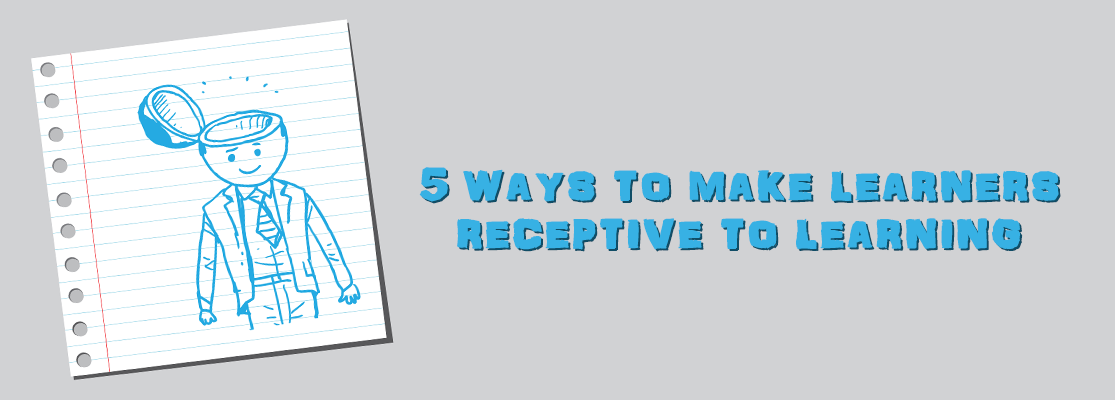5 WAYS TO MAKE LEARNERS RECEPTIVE TO LEARNING
Evan, Laura, and Allen work in the L&D department of a large company. One morning, their manager Helen calls them into her cabin. She says “Congrats! You’re going to DevLearn in Vegas!”
Celebrations ensue, and the three excitedly get ready for the journey. Before leaving, they individually make plans for the trip. Here’s what each of their plans looks like:
EVAN
At the end of the trip, I’d like to:
– Come away with at least three ideas for improving my learning design
– Connect with people who blog on learning, especially those who talk about social learning and community management
– Attend at least four sessions on mobile learning (two of them possibly Clark Quinn’s and Nick Floro’s???)
– Visit Aunt Maurice
Before leaving:
– Buy formal shoes
LAURA
At the conference:
– Attend at least 9 concurrent sessions; squeeze in 12 if possible
– Make notes and consolidate for later reference
In Vegas:
– Go shopping
ALLEN
– 3 days of conference
– Wed Evening: Dinner with friends
– Thurs Evening: Relax in the room
– Friday Evening: Gambling at The Venetian!
– Saturday: Grand Canyon
– Sunday: Flight back
After coming back, Helen asks each of them to present their experiences from the trip.
Can you guess what would have happened?
You’re right! Evan had a clear set of takeaways to present from the conference, while Laura, though a bit scattered, did have a few points to talk about. Allen, unfortunately, had nothing substantial to present. What he did learn at the conference had quickly evaporated, thanks to his lack of goals and focus on learning.
Let’s think about this for a moment. Isn’t this something we encounter all the time? Learners, without as much as an explanation of what to expect, being pushed to attend a day-long training event on compliance (or code of conduct, or communication, or some other topic). Or being forced to take a bunch of long and context-less e-learning courses.
So, unless the learner is in ‘receptive’ mode (by that I mean they are emotionally and intellectually ready to receive the content), it is highly unlikely that a learning event is going to be of any benefit to them. This was exactly what we saw happening with Evan, Laura and Allen above. Despite attending the same conference, and probably sitting through the same sessions and meeting the same bunch of people, the amount of learning that each of them got was directly proportionate to how ‘receptive’ they were.
So, how do we ensure this? How do we make sure that learners are ‘receptive’ to the learning experience that we’ve so painstakingly put together? Here are a few ideas:
1. TELL THEM THE WHY AND THE HOW
This is the ‘What’s In It For Me’, or WIIFM, for the learner. It answers two key questions:
- Why is this topic important? Not to the business, not to the organization, but to me, the learner, as an individual.
- How is it going to help me in my life / work?
WIIFM features prominently in Instructional Design discussions, but gets missed out, or gets improperly implemented in many cases.
But get this one right, and we can have learners hanging on to every word in the course.
2. MAKE AN EMOTIONAL CONNECT
There is a reason that people love stories. And it’s for the same reason that they are addicted to movies and games.
Joy, sorrow, challenge, competition, surprise, suspense, fear, anger, trust… these are just some of the emotions we can draw upon in our courses to keep learners coming back for more.
3. ADDRESS A NEED
Ultimately, the course needs to help the learner get better at something useful. Specifically, it should deliver what it promised to deliver in the WIIFM stage above.
A classic example of this is YouTube videos. It doesn’t matter how good or bad a video is. If it addresses my need of the moment, say ‘how to fix my washing machine’, I would still watch it over and over until I get the information right.
4. MAKE IT BYTE SIZED
No one has the time or the inclination to go through a long-winded course that covers every little obscure detail of the policy you’re trying to cover. Make it to the point, and learners are much more likely to be receptive to the experience.
5. MAKE IT OPTIONAL
This has long remained a pet peeve of mine. Forcibly making learners sit through a class and having them switch off their cell phones does NOT equate to their minds being open to what the class is offering. Same goes for locking down the Next button in the hope that they will read and absorb every little piece of information presented on the screen.
In fact, these strategies have the opposite effect. An individual (especially an adult) who does not feel in control of their circumstances is very unlikely to have an open, receptive mind that is conducive for learning.
Explain the benefits, sell them the idea, and leave it to them to decide whether or not to take the course.
So what have I missed? What other ideas can we use to help learners become ready to receive the content? I would love to hear from you.
Written by Srividya Kumar
(Co-Founder at Learnnovators)
_________________________________
Published on 19-Jan-2017






